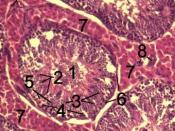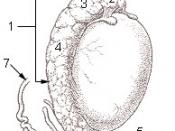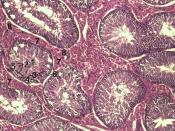Basic Anatomy of the Testicle
The testis (singular) or testicles (plural) is the male gonad. The word testis means "witness" in Latin, and its application to the male gonad originates from ancient Rome, men taking an oath placed one hand on their genitals (Silverthorn, 2001). The testes are contained in a pouch of skin termed the scrotum (Fig. 3a), located outside of the body because they require a temperature 2 - 3 degrees Celsius lower than the rest of the body for gametogenesis. The role of the testis is to produce sperm and masculine hormones, the androgens (e.g. Testosterone). The normal adult male has a pair of the oval shaped organs, each weighing about 25 grams and being 4 -5 centimetres in length and 2-3 centimetres in diameter (Silverthorn, 2001).
Each testis is supported in the scrotum by a tubular structure called the spermatic cord (Fig.1a). Each cord is sheathed in connective tissue and contains a network of arteries (testicular arteries), veins, nerves, and the first section of the ductus deferens, through which sperm pass in the process of ejaculation.
The cords extend from the testes to the inguinal rings (openings at the level of the bladder).
A fibrous sac called the tunica albuginea covers each testis (Fig.2). The tunica albuginea also has extensions into each testis that act as partial partitions to divide the testis into approximately 250 compartments, or lobules. Within each lobe are 3-10 narrow coiled tubules, called seminiferous tubules, which house the testicular machinery (Fig 3b). If uncoiled, these tubules would stretch almost a mile in length, explaining why they account for 90% of the weight of an adult testicle (Rosen, 1998). Both the partitions between the lobes and the seminiferous tubules fuse in one area near the backside of each testis to form a relatively...



Ref list?
Where's the reference list? Maybe I'm blind??
0 out of 0 people found this comment useful.